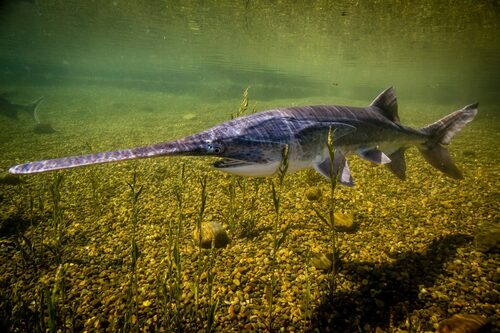
American Paddlefish
The Bluefin Tuna (Thunnus thynnus) is a highly migratory, pelagic fish known for its incredible size, speed, and commercial value. Renowned in culinary circles, particularly for sushi, this species plays a critical role in marine ecosystems. However, it faces significant conservation challenges.
30 55 years
Lifespan
150 - 200 cm
Length
Vulnerable
Conservation Status
25 km/h
Swimming speed
Filter Feeding, Planktivorous
Diet
Local Migration
Migration
Appearance Overview
The Bluefin Tuna is renowned for its large, streamlined body, built for speed and endurance in the open ocean.
Color
Dark metallic blue on top with a silvery underside
Fins
Two dorsal fins, with the second being taller than the first
Body Shape
Torpedo-shaped, designed for efficient swimming
Length
up to 10 feet (3 meters)
Weight
up to 1,500 lbs (680 kg)
Diet
Carnivorous, feeding on fish, squid, and crustaceans
Feeding Behavior
Uses speed to chase down prey, sometimes in coordinated schools
Social Behavior
Solitary, migratory
Commercial Relevance
High value in sushi markets
Conservation measures
Fishing quotas, marine protected areas
Status
Endangered
Threats
Overfishing, climate change, habitat loss
Habitat Distribution
Depth Range
0-900 meters
Geographic Range
Atlantic Ocean, Pacific Ocean, Mediterranean Sea
Preferred Environment
Temperate waters, open ocean
Reproduction and Life Cycle
Breeding Habits
Spawns in warm waters, often near the Gulf of Mexico
Development Stages
Larvae hatch in plankton-rich waters and grow rapidly
Fecundity
Females can produce millions of eggs per season
Maturity Age
Matures at 4-8 years
Faqs about American Paddlefish
Where can Bluefin tuna be found?
Bluefin tuna are found in the Atlantic and Pacific Oceans, often migrating long distances.
Are Bluefin tuna used for food?
Yes, they are highly valued for their meat, especially in sushi and sashimi.
How long do Bluefin tuna live?
They can live up to 40 years.
What makes Bluefin tuna fast swimmers?
Their streamlined body and powerful muscles allow them to swim at high speeds.
What is the biggest threat to Bluefin tuna?
Overfishing is the primary threat, significantly reducing their population.
What do Bluefin tuna eat?
They primarily feed on smaller fish, squid, and crustaceans.
Where do Bluefin tuna breed?
They typically spawn in warm waters, such as the Gulf of Mexico and the Mediterranean Sea.
How fast can Bluefin tuna swim?
They can reach speeds up to 43 mph (70 km/h).
How many eggs can a female Bluefin tuna lay?
Females can release millions of eggs each spawning season.
How are Bluefin tuna populations managed?
Populations are managed through international agreements and fishing quotas.
Copyright @ Nature Style Limited. All Rights Reserved.
 English
English